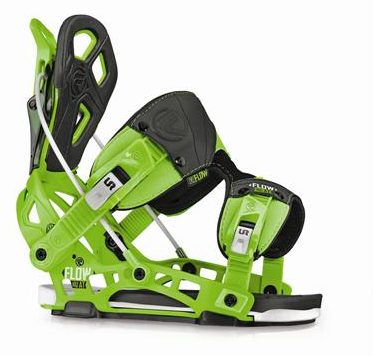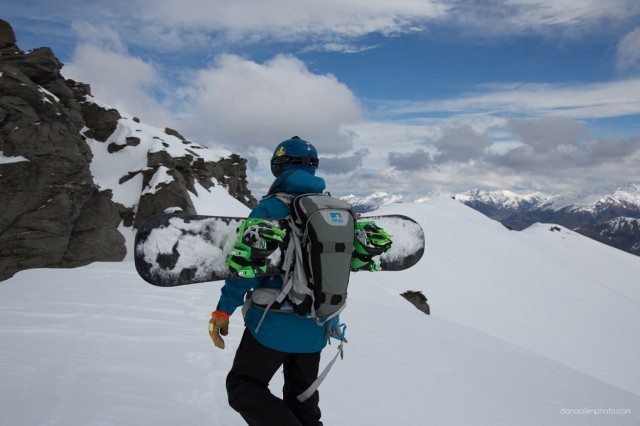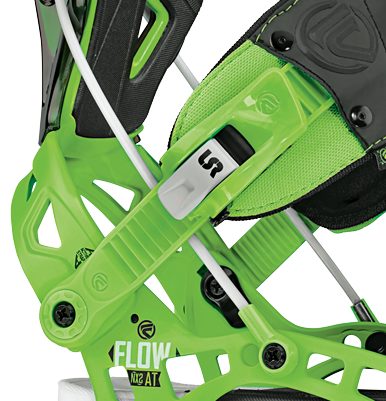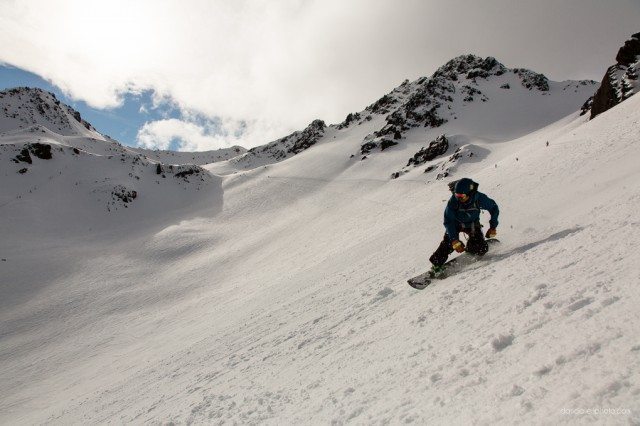
Flow NX2-AT Binding
Size Tested: Medium
Used on K2 Slayblade 158, Flow Maverick 160
MSRP: $299.99
Features
- 2.5º Canted BankBeds
- ModBack w/ Aluminum Alloy Heelcup
- N.A.S.T.Y.
- Active 1-Piece I-FUSION PowerStrap with LSR-buckles
Days Tested: ~2 months
Locations Tested: Taos Ski Valley, NM; A-Basin, Monarch, Crested Butte, CO; South Island, New Zealand
Flow is a snowboard company that, despite making boots, boards, etc., is probably best known for their bindings. That their bindings might overshadow their other products makes some sense, however, since Flow bindings do occupy a special niche.
I started using the Flow NX2-AT bindings after demoing them up at Taos Ski Valley. I found that they were very convenient for when I patrolled there on a snowboard—I didn’t notice any lack of support, and I decided to stick with them.
I’d owned the Flow NXT-ATSE bindings before buying their successor, the NX2-AT. The new model has some alleged improvements over the old NXT-ATSE, including new ratchet straps to give riders more versatility and the “Active Strap Technology.”
Technology
The main feature that sets these bindings apart is the hiback, called the ModBack, which can be reclined to allow fast “rear entry” into the binding. A steel cable connected to the binding’s base gives the ModBack rigidity when it’s engaged. According to Flow, this cable “creates a structural triangular geometry for optimal energy transfer from hiback to baseplate.” We’ll talk about that claim in a bit.
Then there’s the I-Fusion power strap, which essentially covers the entire midfoot of the boot and holds the heel tight to the ModBack. You can keep the unified toe / heel strap attached while you recline the ModBack—a nice feature.
On previous Flow bindings you had to use rear-entry, but the new NX2-AT has fully functional ratchet straps (LSR, or Locking Slap Ratchet buckles) and can be used as a “normal” binding. You can keep the ModBack locked and rely only on the ratchet straps (which are much improved over previous models).
I used both options, and found that this versatility was my favorite feature of these bindings.
Strapping In
- “Rear Entry”
While some riders I know tend to avoid this binding style, I’m a huge fan of Flow’s reclining hiback, and I think the updated model improves upon this already strong design. In my opinion, a hiback that fold downs makes one aspect of riding much more convenient.
On steep icy slopes (that can’t be shaped into a flat platform), I prefer to face the slope rather than risk sliding down on my caboose. When strapping in facing away from the slope, the risk of sliding and / or dropping the board increases. With the ModBack, it’s easy to slide my boot into the binding without turning my back to the hill. This method also frees up my hands to stabilize myself.
If you’re strapping in toe-side to the hill without rear entry, you’ll need to stabilize the board with one hand while the other adjusts the strap. I personally prefer having one hand free for balance and the rear-entry allows me to do so.
I spent some time in the Club Fields of New Zealand enjoying the August and September snow this year. These areas have great hike-to terrain, and all that hiking to “sweet as” lines had me in and out of my bindings often. While on the rope tows, both my feet were strapped in—since these rope tows end quickly, I would have to unstrap quickly. I’d exit the bindings from the back, which helped me keep an edge in the snow while facing the hill.

- Ratchet Straps
I found the traditional, much-improved ratchet straps of the NX2-AT tremendously useful when I strapped into the bindings with my back to the slope.
When you’re facing away from the slope, rear entry isn’t an option since the ModBack can’t recline. Enter the “Ratchet Buckles.” The old NXT-ATSE had a simple spring-loaded buckle that gripped the ladder strap, but it wasn’t very adjustable once you strapped in. You had to pre-adjust it for the boot with the idea being that once the hiback was closed, your boot would sit securely due to the pre-adjusted strap length.
But I’m constantly adjusting my binding straps from pretty loose to very tight depending on the terrain and snow conditions, and I wanted more adjustability. And thankfully, the changes to the new NX2-AT give me just that. The new bindings, with their LSR buckles, have adjustable ratchets on the ladder connection.

What’s the takeaway here? With the NXT2-AT, you can use the normal “through-the-top-and-use-the-straps” method or the Flow “rear-entry” method. I found myself using both options frequently.
I’ve never been more comfortable in bindings or more excited about my strap-in options than with the NX2-AT. I think Flow made a very innovative move to combine these two methods.

Flex / Stiffness
Most bindings without the reclining ModBack rely on a heel cup for rigidity and responsiveness. Varying degrees of binding flex from “kinda soft” to “fairly stiff” are governed by the binding base, hiback, and heel cup. The NX2-AT bindings are pretty stiff, similar to the Burton Cartel or the Flux SF, but due to the nature of Flow’s ModBack, there’s no traditional heel cup.
So how did the company make the bindings stiff?
The stiffness comes from the steel cable that connects to the bindings aluminum base and runs through the back of the ModBack. A little knob adjusts the length of the cable to determine forward lean. The knob is threaded, letting you make small-increment adjustments.
(To give you an idea of the strength of the cable and the stiffness it gives to the bindings, let me relay an anecdote. I’d responded to an injury at Taos Ski Valley while working patrol on my board. I was in the Bambi chutes, a place that offers some of the best stashes of tree skiing on the hill.
I’d placed my board upside down in the snow near the patient and, during the shuffle, the board got kicked over and took off down the hill. The ModBack nailed a tree and snapped in half. But with the cable, I was still able to click in. Even without the ModBack, I was solidly attached to the binding because of the cable.)
The Flow NX2-AT also use a thick, combined toe and heel strap, which contributes to the bindings stiffness. It doesn’t cap the toe, like other popular bindings, but it supports the foot and give you solid heel grip. The feel is similar to the K2 Auto-Uprise bindings, but much more adjustable.
You can adjust the ModBack’s height, but not rotation. I never fiddled with the factory setting, and didn’t feel I needed to. They are so stiff to begin with that the advantage of having a rotational highback would be moot, in my opinion. That said, I wouldn’t recommend these for serious park riding.

Kudos on a great, thorough review on the nx2-ats! Very detailed and informational. I’ve been eyeing these bindings for a few months and found your review very helpful.
Thanks!
I found them disappointing, bought them 1 month ago and tried them in Austia 2 weeks ago.
First, closing the hiback (ModBack) was problematic, the lower part of het hiback kept getting stucked behind the heel of my shoe, even after loosing up the front.
Only after loosing up the front a lot it was possible to close the hiback, but after that I needed to tighten up the straps again. Very odd for a XL binding size which should fit shoes up to
size 49,5 (US 15).
Second, the lever at the back of the hiback sticks out a bit, so every time I slided through the ski-ticket gate carrousel, there was a change that the bar of the carrousel hit the lever down
opening my highback. There were a few occasions where I almost lost my snowboard in the ski lift because the hiback was opened by the carrousel.
Third, the highback was a bit too long and pointy which made it getting stucked behind fences and bars when it was opened to get in to the ski-lift.
finally When the bindings where closed and adjusted, the ride down was brilliant. The bindings are very stiff and rigid, so lots of control, especially combined with the new snowboard. Used the strap buckles a few times when I got stucked in the ‘tiefschnee’, no problems with that.
All in all, the new bindings made getting in and out of the ski-lift more difficult, something a Flow binding should make easier.
How do they flatten down? Would they fit in a standard Dakine snowboard bag?
You can fold the back down flat for storage in your snowboard bag. You have to fully release the tow/heel strap, fold the hi-back down, and then re-attach the tow/heel strap. I have the DaKine Low-Roller bag and a Ride Yukon 172 with Flow NX2-AT bindings.
Can I fit the large size of these bindings on the slayblade??
Thanks
The best thing to do with these is loosen up both buckles just a little on your binding, so ur foot slides in perfect when strapping in and lock up the hi back, quick small rachet for both straps and off u go..
That’s the best way.. Once u lock up the high back u can always rachet down as ur moving… It’s pretty hard to slide ur foot into the binding when ur straps have been tightened hard from the run before, so just loosen both buckles a few notches, and save urself the crap of trying to kick ur foot hard into a tight binding
All in all once ur smooth with them u laugh at the idiots sitting down to strap in, they are a great binding
Great review. Wife and I both love these bindings. The front uni strap is very comfy and we get in/out super fast, in fact possibly get extra run in because of it. I even will get off lift sometimes an stuff rear foot in while gliding an then reach down and secure the back never even stopping. When with skiers they appreciate the rapidity of strapping in too. They are stiff an wouldn’t probably be great for landing jumps an stuff but they are my favorite for steep sketchy stuff an carving it up. I’m thinking of getting the regular NXT for moguls and more freestyle just not park. Any suggestions?